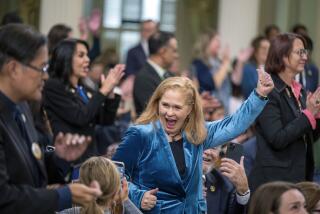NEWS ANALYSIS : Disputes Sap Assembly’s Power : Politics: Bitter partisanship in the evenly divided chamber increases amid strains of term limits and recall threats. Influence shifts to the Senate and governor as a result.
SACRAMENTO — The Assembly leadership struggle that ended with Willie Brown regaining the speakership over bitter Republican protests was one of the last gasps of the old guard in the lower house.
But as the old-timers disappear, newcomers are learning their elders’ lessons well. Take Assemblyman Larry Bowler, a Republican from suburban Sacramento who has been in the Legislature two years.
He grew so distrustful of Democrats so fast that when he noticed microphones in the Capitol meeting room where Republicans were talking political strategy, Bowler borrowed a pocket knife and cut the wires.
Noting that Brown always seemed to know what was going on in Republican minds, Bowler explained: “It’s either one of us telling him or it’s him eavesdropping. It is easy for me to cut the wires . . . and eliminate that possibility, and that’s what I did.”
Several Republicans applauded the act. Brown called it criminal vandalism and asked state police to investigate.
Welcome to the new Assembly.
A rapidly changing institution marked by increased turnover caused by term limits, the Assembly is showing signs of becoming even more contentious than it was in years past, while the few remaining veterans are frustrated as the lower house loses power to the more stable Senate and the governor.
“It’s kind of like Yugoslavia. Tito is dying,” said Steve Thompson, a former Brown aide who is executive director of the California Medical Assn., one of the most powerful interests in Sacramento.
The Assembly is split with 39 Democrats and 39 Republicans, plus an independent who is a Brown loyalist. There is also a vacancy--created last week when Brown marshaled his forces in an extraordinary power play to oust Republican Richard Mountjoy of Arcadia. That broke the leadership deadlock, and allowed Brown to regain the speakership.
But the Assembly over which Brown will preside is weakened. The remaining veterans must depart at the end of this two-year session because of term limits. Brown, entering his 31st year in the Assembly, is among the lame ducks.
First- and second-termers make up two-thirds of the Assembly. But few new members showed a willingness to push the veterans out of power. Instead, they fell into line behind the party leaders. One reason is that party leaders remain vital for fund raising.
“These folks are dependent on special interests,” said Ruth Holton of California Common Cause, a backer of a possible initiative on the 1996 ballot limiting campaign spending and fund raising. “They still have to run for office three times (under term limits), and many will get bitten by the bug and they will run for the Senate.”
Experts in and out of the Capitol say the new Assembly will be like the minor league Albuquerque Dukes, the Dodgers’ farm team, with players staying only as long as it takes to reach the big leagues, in the form of some higher office. Some say it risks tilting toward irrelevance, retaining only its authority to approve the state budget.
“The Assembly will be where people learn how Sacramento works,” said Assembly Republican Leader Jim Brulte, noting that senators increasingly will come from the ranks of the lower house.
Brulte and Brown both are considering running for the state Senate. If they and other veterans of the speakership fight win seats in the upper house, they will bring their battle scars with them, perhaps making the Senate more partisan.
Through all this, Brulte noted, “the governor, no matter which party he or she comes from, becomes incredibly more powerful.”
Already, Assemblywoman Martha Escutia (D-Huntington Beach), entering her second term, has noticed that fewer lobbyists have come calling on her to seek support for their causes than they did in her first term.
“They’re seeing the Senate is the more stable house,” Escutia said. “If I had a client to represent, that’s where I would go first.”
In some ways, the new Assembly could be a throwback to the 1950s and earlier, when weak Speakers held power for a year or two, and the Senate was the center of legislative power.
The late Jesse Unruh changed that relationship when, as Speaker in the 1960s, he transformed the Assembly into a “professional” body, with full-time legislators and a staff of experienced policy experts.
Under Unruh and the Speakers since him, the lower house often drove California’s legislative agenda--to the benefit of Democrats who controlled the Assembly for all but two years in the past three decades.
Now the Assembly “is sort of an unraveling,” said Alan Rosenthal, a political scientist at Rutgers University in New Jersey who studies state legislatures. “I’m not sure how you un-unravel the California (Assembly). You have to get the leaders to come together on a bicameral basis. But that means they have to agree on the value of the institution, and I’m not sure you can find that.”
Assembly boundaries drawn by the state Supreme Court have created more competitive districts, leading to more swing seats. That suggests that the Assembly may become more bipartisan in the years ahead. But, in the aftermath of the acrimonious speakership battle, there is little evidence of harmony in the short term, beyond promises by party leaders Brown and Brulte that they will work together.
In fact, many other members talk of revenge and recalls.
Republicans have been working to recall former Republican Assemblyman Paul Horcher of Diamond Bar since December when he bolted his party to support Brown as Speaker. GOP leaders also appear increasingly serious about seeking the recall of five Democrats who voted for Brown as Speaker, and for Mountjoy’s ouster.
Democrats and Horcher voted to expel Mountjoy, contending he was remaining in the Assembly only because he wanted to influence the speakership fight, even though he had won a special election for a Senate seat in November.
The recalls “portend chaos--continual chaos, as opposed to occasional chaos,” said Bob Stern of the Center for Governmental Studies in Los Angeles. Any member facing recall is “not likely to vote for the budget (proposed by Republican Gov. Pete Wilson) or any Republican bills.”
Brulte tries to distance himself from the demands for recalls against Democrats. But Bowler, who has taken to wearing a black lapel ribbon in protest of Brown’s seizure of the speakership, says he intends to raise money to recall freshman Democratic Assemblyman Mike Machado, who comes from a swing district in Stockton, because of Machado’s support for Brown.
Brown is threatening to withhold support of the budget this summer because of the governor’s involvement in the Horcher recall. Other Democrats cite bitterness over Wilson’s 1994 reelection campaign, saying they have no reason to vote for anything that might help him in a presidential bid next year.
Mike Schroeder, a state Republican Party official who is heading a campaign committee to recall Brown supporters, named five Democrats who will be recall targets, saying their offense was supporting Brown as Speaker after promising in their campaigns that they would be independent of him. Schroeder said he expects signature-gathering to start in early February.
“The recall is a tool that you’re going to see employed more often, because it fits the mood of the electorate,” said Schroeder, who helped organize last year’s unsuccessful recall of then-state Sen. David A. Roberti of Van Nuys. “The electorate is more angry, and they are less willing to put up with politicians who break faith with them.”
As legislators see it, recalls, especially over party-line votes cast in a leadership fight, hit below the belt. Schroeder acknowledged that the recalls “probably will have the effect of making the Assembly more partisan--but it is hard to imagine it getting worse than it is.”
More to Read
Get the L.A. Times Politics newsletter
Deeply reported insights into legislation, politics and policy from Sacramento, Washington and beyond. In your inbox three times per week.
You may occasionally receive promotional content from the Los Angeles Times.










